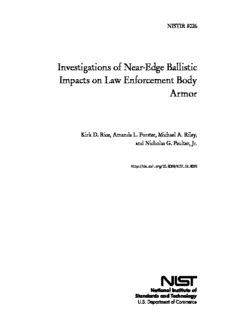
Investigations of Near-Edge Ballistic Impacts on Law Enforcement Body Armor PDF
Preview Investigations of Near-Edge Ballistic Impacts on Law Enforcement Body Armor
NISTIR 8026 Investigations of Near-Edge Ballistic Impacts on Law Enforcement Body Armor Kirk D. Rice, Amanda L. Forster, Michael A. Riley, and Nicholas G. Paulter, Jr. http://dx.doi.org/10.6028/NIST.IR.8026 NISTIR 8026 Investigations of Near-Edge Ballistic Impacts on Law Enforcement Body Armor Kirk D. Rice, Amanda L. Forster, Michael A. Riley, and Nicholas G. Paulter, Jr. MaterialsMeasurementScienceDivision MaterialMeasurementLaboratory Thispublicationisavailablefreeofchargefrom: http://dx.doi.org/10.6028/NIST.IR.8026 September2014 U.S.DepartmentofCommerce PennyPritzker,Secretary NationalInstituteofStandardsandTechnology WillieMay,ActingUnderSecretaryofCommerceforStandardsandTechnology,andActingDirector Abstract In2005and2006,twolawenforcementofficer-involvedshootingsresultedinin- juries to the officers when bullets were not stopped in the officers’ body armor. Inbothcases,thebulletsstrucktheofficers’armorquiteclosetotheedgeofthe ballistic-resistant panel. In each case, the National Institute of Justice(NIJ) and the law enforcement agencies involved had several concerns. Was the armor’s responseindicativeofaseriousproblemwiththearmor? Wasthearmorperfor- mance degrading significantly during use? Were similar armors being worn by otherlawenforcementofficersprovidingtheexpectedlevelofprotection? The National Institute of Standards and Technology (NIST) investigated how each of the armors performed, including examining the shot panels, per- forming ballistic testing, and measuring select material properties of samples of ballistic-resistantmaterialfromthearmors,inordertoprovideguidancetoNIJ. The research effort concluded that in both cases the bullets struck the body ar- mortooclosetoanedgeforthearmortobeabletoreliablystopthebullet. The results of ballistic testing on one incident armor and a similar armor indicated thatthearmorsappearedtoprovidesufficientprotectionwhenstruckbybullets away from the edge, in the region normally tested during compliance testing. Material property testing found that there were some indications of changes to theballistic-resistantmaterialsduetouse,butnoindicationsofsignificantdegra- dationinthematerials. v InvestigationsofNear-EdgeBallisticImpactsonLawEnforcementBodyArmor Thispageintentionallyleftblank. vi Acknowledgments FinancialsupportforthisresearcheffortwasprovidedbytheNationalInstitute ofJusticeunderInteragencyAgreementNumbers2003-IJ-R-029and2008-DN-R- 121,bytheCommunityOrientedPolicingServicesOffice,andbyNIST. Their supportisgratefullyacknowledged. ThePanamaCityBeachPoliceDepartmentandBureauofAlcohol,Tobacco, Firearms and Explosives assisted with and provided information related to the PanamaCityBeacharmorinvestigation. TheTampaPoliceDepartmentprovidedextensiveinformation,sparearmor, andassistancethatmadetheinvestigationintotheTampaincidentpossible. TheNationalLawEnforcementandCorrectionsTechnologyCenterassisted with contacting law enforcement agencies, provided information on compli- ance test results, and provided chain-of-custody for incident armors that were inspectedatNIST. Theauthorsthankallofthemfortheirvaluableassistance. vii InvestigationsofNear-EdgeBallisticImpactsonLawEnforcementBodyArmor Thispageintentionallyleftblank. viii Disclaimer Certain commercial products, equipment, instruments, or materials are identi- fied in this paper in order to adequately describe the items that were used in thedescribedofficer-involvedshootingsandintheinvestigativetestingdescribed herein. Suchidentificationortheuseofbrandnamesinthisdocumentdoesnot constitute recommendation or endorsement by the U.S. Department of Com- merce; National Institute of Standards and Technology; or any other agency of theUnitedStatesFederalGovernment,nordoesitimplythattheproductisbest suitedforthisorotherapplications. ix InvestigationsofNear-EdgeBallisticImpactsonLawEnforcementBodyArmor Thispageintentionallyleftblank. x
Description: